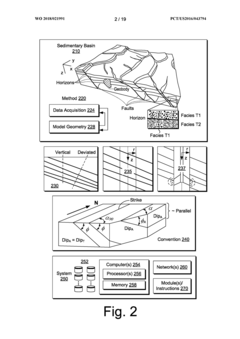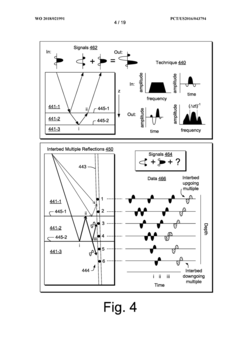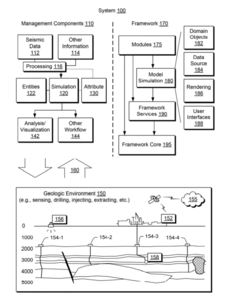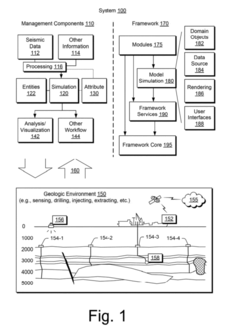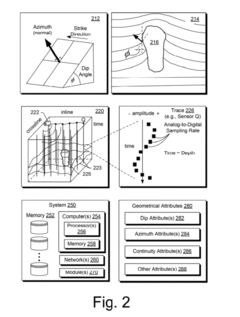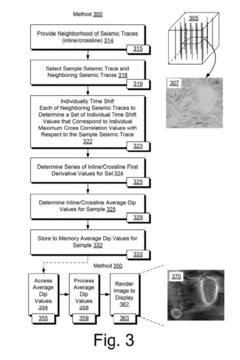Development of High Pass Filters for Enhanced Seismic Data Interpretation
JUL 28, 20259 MIN READ
Generate Your Research Report Instantly with AI Agent
Patsnap Eureka helps you evaluate technical feasibility & market potential.
Seismic Filtering Evolution and Objectives
Seismic filtering techniques have evolved significantly since the early days of seismic exploration. The primary objective of these filters has been to enhance the quality of seismic data interpretation by removing unwanted noise and highlighting key geological features. High-pass filters, in particular, have played a crucial role in this evolution, allowing geophysicists to focus on high-frequency components of seismic signals that often contain valuable information about subsurface structures.
The development of high-pass filters for seismic data interpretation can be traced back to the 1960s when digital signal processing techniques began to be applied to geophysical data. Initially, simple frequency-domain filters were used to attenuate low-frequency noise. As computational power increased, more sophisticated time-domain and frequency-domain filters were developed, enabling more precise control over the filtering process.
One of the key objectives in the evolution of seismic filtering has been to improve the signal-to-noise ratio (SNR) of seismic data. High-pass filters have been instrumental in achieving this goal by suppressing low-frequency ambient noise and ground roll, which often mask important reflection events. This has led to clearer images of subsurface structures and improved accuracy in identifying potential hydrocarbon reservoirs.
Another important objective has been to enhance the resolution of seismic data. High-pass filters have contributed significantly to this effort by preserving and emphasizing high-frequency components of the seismic signal. These components are crucial for resolving thin beds and small-scale geological features that are often of great interest in hydrocarbon exploration and production.
The development of adaptive and non-linear filtering techniques has been a major milestone in seismic data processing. These advanced filters can adjust their parameters based on the local characteristics of the seismic data, allowing for more effective noise suppression while preserving important signal information. This adaptability has been particularly valuable in dealing with complex geological settings where traditional fixed-parameter filters may struggle.
In recent years, the integration of machine learning and artificial intelligence into seismic filtering has opened up new possibilities. These technologies have enabled the development of intelligent filtering algorithms that can learn from large datasets and automatically identify and remove noise patterns, further improving the quality of seismic interpretations.
Looking forward, the objectives of high-pass filter development for seismic data interpretation continue to evolve. Current research focuses on improving the ability to distinguish between noise and signal in increasingly challenging environments, such as deep-water and sub-salt imaging. Additionally, there is a growing emphasis on developing filters that can handle the massive volumes of data generated by modern seismic acquisition techniques, including full-waveform inversion and 4D seismic surveys.
The development of high-pass filters for seismic data interpretation can be traced back to the 1960s when digital signal processing techniques began to be applied to geophysical data. Initially, simple frequency-domain filters were used to attenuate low-frequency noise. As computational power increased, more sophisticated time-domain and frequency-domain filters were developed, enabling more precise control over the filtering process.
One of the key objectives in the evolution of seismic filtering has been to improve the signal-to-noise ratio (SNR) of seismic data. High-pass filters have been instrumental in achieving this goal by suppressing low-frequency ambient noise and ground roll, which often mask important reflection events. This has led to clearer images of subsurface structures and improved accuracy in identifying potential hydrocarbon reservoirs.
Another important objective has been to enhance the resolution of seismic data. High-pass filters have contributed significantly to this effort by preserving and emphasizing high-frequency components of the seismic signal. These components are crucial for resolving thin beds and small-scale geological features that are often of great interest in hydrocarbon exploration and production.
The development of adaptive and non-linear filtering techniques has been a major milestone in seismic data processing. These advanced filters can adjust their parameters based on the local characteristics of the seismic data, allowing for more effective noise suppression while preserving important signal information. This adaptability has been particularly valuable in dealing with complex geological settings where traditional fixed-parameter filters may struggle.
In recent years, the integration of machine learning and artificial intelligence into seismic filtering has opened up new possibilities. These technologies have enabled the development of intelligent filtering algorithms that can learn from large datasets and automatically identify and remove noise patterns, further improving the quality of seismic interpretations.
Looking forward, the objectives of high-pass filter development for seismic data interpretation continue to evolve. Current research focuses on improving the ability to distinguish between noise and signal in increasingly challenging environments, such as deep-water and sub-salt imaging. Additionally, there is a growing emphasis on developing filters that can handle the massive volumes of data generated by modern seismic acquisition techniques, including full-waveform inversion and 4D seismic surveys.
Geophysical Industry Demand Analysis
The geophysical industry has witnessed a significant surge in demand for advanced seismic data interpretation techniques, particularly in the development of high pass filters. This growing need is driven by the increasing complexity of subsurface structures and the ever-present challenge of extracting meaningful information from noisy seismic data.
In the oil and gas sector, which remains a primary driver of geophysical exploration, the demand for enhanced seismic interpretation tools is particularly acute. As easily accessible hydrocarbon reserves become scarce, companies are compelled to explore more challenging geological environments, including deep-water offshore areas and unconventional reservoirs. These complex settings require more sophisticated data processing and interpretation methods to accurately identify potential hydrocarbon traps and optimize drilling locations.
The mining industry also contributes substantially to the demand for improved seismic data interpretation. As near-surface mineral deposits become depleted, exploration is moving towards deeper targets, necessitating more precise imaging and interpretation of subsurface structures. High pass filters play a crucial role in enhancing the resolution of seismic data, allowing geologists to better identify mineral-bearing formations and structural features that may host economic deposits.
Environmental and engineering applications represent another growing market for advanced seismic interpretation techniques. Groundwater resource management, geothermal energy exploration, and civil engineering projects all benefit from improved subsurface imaging. High pass filters are particularly valuable in these contexts for detecting small-scale features such as fractures, faults, and variations in rock properties that can significantly impact project outcomes.
The academic and research sectors also drive demand for enhanced seismic data interpretation tools. As geoscientists strive to better understand Earth's structure and processes, they require increasingly sophisticated methods to analyze seismic data. High pass filters are essential for revealing fine-scale features in crustal and mantle studies, as well as in seismological research aimed at improving earthquake prediction and hazard assessment.
Emerging technologies such as machine learning and artificial intelligence are creating new opportunities and challenges in seismic data interpretation. These advanced analytical tools require high-quality input data to function effectively, further emphasizing the importance of robust filtering techniques like high pass filters in the pre-processing stage.
The global nature of geophysical exploration and research has led to a worldwide demand for improved seismic interpretation tools. Developing countries with untapped natural resources are investing heavily in geophysical surveys, creating new markets for advanced data processing and interpretation technologies. Simultaneously, established markets in North America, Europe, and Asia continue to drive innovation in this field as they seek to maximize the value of existing data and improve exploration efficiency.
In the oil and gas sector, which remains a primary driver of geophysical exploration, the demand for enhanced seismic interpretation tools is particularly acute. As easily accessible hydrocarbon reserves become scarce, companies are compelled to explore more challenging geological environments, including deep-water offshore areas and unconventional reservoirs. These complex settings require more sophisticated data processing and interpretation methods to accurately identify potential hydrocarbon traps and optimize drilling locations.
The mining industry also contributes substantially to the demand for improved seismic data interpretation. As near-surface mineral deposits become depleted, exploration is moving towards deeper targets, necessitating more precise imaging and interpretation of subsurface structures. High pass filters play a crucial role in enhancing the resolution of seismic data, allowing geologists to better identify mineral-bearing formations and structural features that may host economic deposits.
Environmental and engineering applications represent another growing market for advanced seismic interpretation techniques. Groundwater resource management, geothermal energy exploration, and civil engineering projects all benefit from improved subsurface imaging. High pass filters are particularly valuable in these contexts for detecting small-scale features such as fractures, faults, and variations in rock properties that can significantly impact project outcomes.
The academic and research sectors also drive demand for enhanced seismic data interpretation tools. As geoscientists strive to better understand Earth's structure and processes, they require increasingly sophisticated methods to analyze seismic data. High pass filters are essential for revealing fine-scale features in crustal and mantle studies, as well as in seismological research aimed at improving earthquake prediction and hazard assessment.
Emerging technologies such as machine learning and artificial intelligence are creating new opportunities and challenges in seismic data interpretation. These advanced analytical tools require high-quality input data to function effectively, further emphasizing the importance of robust filtering techniques like high pass filters in the pre-processing stage.
The global nature of geophysical exploration and research has led to a worldwide demand for improved seismic interpretation tools. Developing countries with untapped natural resources are investing heavily in geophysical surveys, creating new markets for advanced data processing and interpretation technologies. Simultaneously, established markets in North America, Europe, and Asia continue to drive innovation in this field as they seek to maximize the value of existing data and improve exploration efficiency.
High Pass Filter Technology Status
High pass filters have become an essential tool in seismic data interpretation, significantly enhancing the quality and accuracy of subsurface imaging. Currently, the technology status of high pass filters in this domain is characterized by advanced digital signal processing techniques and sophisticated algorithms.
The most prevalent high pass filter implementations utilize finite impulse response (FIR) and infinite impulse response (IIR) designs. FIR filters, known for their linear phase response and stability, are widely adopted in seismic processing workflows. They offer precise control over the passband and stopband characteristics, crucial for isolating high-frequency components in seismic signals.
IIR filters, while less common, provide steeper roll-off rates and require fewer coefficients, making them computationally efficient for real-time applications. However, their non-linear phase response necessitates careful design considerations to minimize phase distortion in seismic data.
Recent advancements in adaptive filtering techniques have led to the development of high pass filters that can dynamically adjust their parameters based on the input signal characteristics. These adaptive filters show promise in handling non-stationary seismic data, effectively suppressing low-frequency noise while preserving valuable high-frequency information.
Frequency-domain filtering methods, such as the Fast Fourier Transform (FFT) based high pass filters, have gained traction due to their ability to process large seismic datasets efficiently. These methods allow for precise spectral shaping and are particularly effective in removing DC offset and long-period trends from seismic traces.
Wavelet-based high pass filtering techniques have emerged as a powerful alternative, offering multi-resolution analysis capabilities. These filters can effectively separate different frequency components while maintaining good temporal localization, which is crucial for preserving subtle stratigraphic features in seismic data.
The integration of machine learning algorithms with high pass filtering has opened new avenues for automated parameter selection and optimization. Convolutional neural networks and deep learning models are being explored to design intelligent high pass filters that can adapt to complex geological settings and varying noise profiles.
Current research focuses on developing high pass filters that can operate effectively in the presence of non-Gaussian noise, a common challenge in seismic data acquisition. Robust statistical approaches and median-based filtering techniques are being investigated to improve filter performance in such scenarios.
The ongoing trend towards real-time seismic data processing has driven the development of hardware-accelerated high pass filtering solutions. Field-programmable gate arrays (FPGAs) and graphics processing units (GPUs) are increasingly being utilized to implement high-performance, low-latency high pass filters capable of processing massive seismic datasets in near real-time.
The most prevalent high pass filter implementations utilize finite impulse response (FIR) and infinite impulse response (IIR) designs. FIR filters, known for their linear phase response and stability, are widely adopted in seismic processing workflows. They offer precise control over the passband and stopband characteristics, crucial for isolating high-frequency components in seismic signals.
IIR filters, while less common, provide steeper roll-off rates and require fewer coefficients, making them computationally efficient for real-time applications. However, their non-linear phase response necessitates careful design considerations to minimize phase distortion in seismic data.
Recent advancements in adaptive filtering techniques have led to the development of high pass filters that can dynamically adjust their parameters based on the input signal characteristics. These adaptive filters show promise in handling non-stationary seismic data, effectively suppressing low-frequency noise while preserving valuable high-frequency information.
Frequency-domain filtering methods, such as the Fast Fourier Transform (FFT) based high pass filters, have gained traction due to their ability to process large seismic datasets efficiently. These methods allow for precise spectral shaping and are particularly effective in removing DC offset and long-period trends from seismic traces.
Wavelet-based high pass filtering techniques have emerged as a powerful alternative, offering multi-resolution analysis capabilities. These filters can effectively separate different frequency components while maintaining good temporal localization, which is crucial for preserving subtle stratigraphic features in seismic data.
The integration of machine learning algorithms with high pass filtering has opened new avenues for automated parameter selection and optimization. Convolutional neural networks and deep learning models are being explored to design intelligent high pass filters that can adapt to complex geological settings and varying noise profiles.
Current research focuses on developing high pass filters that can operate effectively in the presence of non-Gaussian noise, a common challenge in seismic data acquisition. Robust statistical approaches and median-based filtering techniques are being investigated to improve filter performance in such scenarios.
The ongoing trend towards real-time seismic data processing has driven the development of hardware-accelerated high pass filtering solutions. Field-programmable gate arrays (FPGAs) and graphics processing units (GPUs) are increasingly being utilized to implement high-performance, low-latency high pass filters capable of processing massive seismic datasets in near real-time.
Current High Pass Filter Solutions
01 Application of high-pass filters in seismic data processing
High-pass filters are used in seismic data processing to remove low-frequency noise and enhance the visibility of high-frequency signals. This technique improves the resolution and clarity of seismic images, allowing for better interpretation of subsurface structures and geological features.- Application of high-pass filters in seismic data processing: High-pass filters are used in seismic data processing to remove low-frequency noise and enhance the visibility of high-frequency signals. This technique improves the resolution and clarity of seismic images, allowing for better interpretation of subsurface structures and geological features.
- Integration of high-pass filters with other seismic processing techniques: High-pass filters are often combined with other seismic processing techniques such as deconvolution, migration, and stacking to enhance the overall quality of seismic data. This integrated approach helps in reducing noise, improving signal-to-noise ratio, and increasing the accuracy of subsurface imaging.
- Adaptive high-pass filtering for seismic data interpretation: Adaptive high-pass filtering techniques are developed to automatically adjust filter parameters based on the characteristics of the seismic data. This approach optimizes the filtering process for different geological settings and improves the effectiveness of noise suppression while preserving important signal information.
- High-pass filtering in time-frequency domain analysis: High-pass filtering is applied in the time-frequency domain to analyze seismic data. This method allows for better separation of signal and noise components, enabling more accurate interpretation of seismic events and stratigraphic features across different frequency bands.
- Machine learning-based high-pass filtering for seismic interpretation: Machine learning algorithms are employed to optimize high-pass filtering parameters and enhance seismic data interpretation. These advanced techniques can automatically identify and remove noise patterns, improve signal detection, and assist in the interpretation of complex geological structures.
02 Integration of high-pass filters with other seismic processing techniques
High-pass filters are often combined with other seismic processing techniques, such as deconvolution and migration, to enhance the overall quality of seismic data. This integrated approach helps in reducing artifacts, improving signal-to-noise ratio, and providing more accurate subsurface imaging for interpretation.Expand Specific Solutions03 Adaptive high-pass filtering for seismic data interpretation
Adaptive high-pass filtering techniques are developed to automatically adjust filter parameters based on the characteristics of the seismic data. This approach optimizes the filtering process for different geological settings and noise conditions, resulting in improved data quality and more reliable interpretations.Expand Specific Solutions04 High-pass filtering in time-frequency domain analysis
High-pass filtering is applied in the time-frequency domain to analyze seismic data. This method allows for better separation of signal and noise components, enabling more accurate identification of geological features and improved interpretation of complex subsurface structures.Expand Specific Solutions05 Machine learning-based high-pass filtering for seismic interpretation
Machine learning algorithms are employed to optimize high-pass filtering parameters and enhance seismic data interpretation. These advanced techniques can automatically identify and remove noise patterns, improve signal quality, and assist in the interpretation of complex geological structures.Expand Specific Solutions
Key Players in Geophysical Software
The development of high pass filters for enhanced seismic data interpretation is in a mature stage, with a competitive landscape dominated by major oil and gas companies and specialized geophysical service providers. The market size is substantial, driven by the ongoing need for accurate subsurface imaging in hydrocarbon exploration and production. Key players like Saudi Aramco, Schlumberger, and China National Petroleum Corporation are investing heavily in advanced seismic technologies. These companies, along with others such as PetroChina and BGP Inc., are at the forefront of technological advancements, continuously improving filter designs and data processing algorithms to enhance seismic data quality and interpretation accuracy.
Schlumberger Canada Ltd.
Technical Solution: Schlumberger has developed advanced high-pass filtering techniques for seismic data interpretation, leveraging their proprietary OMEGA seismic processing platform[1]. Their approach combines adaptive filtering algorithms with machine learning to enhance signal-to-noise ratios in complex geological settings. The company's high-pass filters are designed to remove low-frequency noise while preserving important high-frequency seismic events, crucial for detailed reservoir characterization. Schlumberger's technology incorporates real-time processing capabilities, allowing for on-the-fly adjustments during seismic surveys, which significantly improves data quality and reduces processing time[2]. Their filters are particularly effective in suppressing surface-related and ambient noise, enabling clearer imaging of subsurface structures.
Strengths: Industry-leading seismic processing technology, global presence, and extensive R&D capabilities. Weaknesses: High costs associated with proprietary technology and potential over-reliance on software solutions.
BGP, Inc.
Technical Solution: BGP has innovated in high-pass filter development for seismic data interpretation through their GeoEast seismic processing and interpretation system[3]. Their approach focuses on frequency-domain decomposition and adaptive noise attenuation. BGP's high-pass filters utilize advanced wavelet transform techniques to separate signal from noise across multiple frequency bands. The company has also implemented machine learning algorithms to optimize filter parameters based on geological settings and acquisition parameters. BGP's filters are particularly effective in handling complex onshore environments with significant surface-related noise[4]. Their technology includes real-time quality control mechanisms, ensuring optimal filter performance during data acquisition and processing stages.
Strengths: Strong expertise in land seismic operations, cost-effective solutions, and adaptability to challenging terrains. Weaknesses: Less prominent in offshore seismic markets and potential limitations in global market reach compared to Western competitors.
Innovative High Pass Filter Designs
Seismic spectral balancing
PatentWO2018021991A1
Innovation
- The method involves iteratively filtering seismic data using band-pass filters across multiple frequency bands, subtracting extracted information after each iteration, and balancing the data to generate spectrally balanced seismic data, which enhances the resolution and clarity of subsurface features by normalizing each frequency band independently.
Dip seismic attribute
PatentInactiveUS20120320712A1
Innovation
- A method involving time shifting of seismic traces to determine maximum cross correlation values, calculating first derivative values, and computing average dip angles, followed by processing and rendering these values to enhance visualization and interpretation of seismic data.
Environmental Impact of Seismic Surveys
Seismic surveys, while essential for geological exploration and resource discovery, have significant environmental impacts that must be carefully considered and mitigated. The use of high-energy sound waves in marine environments can have both immediate and long-term effects on marine ecosystems and wildlife.
One of the primary concerns is the impact on marine mammals, particularly cetaceans such as whales and dolphins. These animals rely heavily on sound for communication, navigation, and foraging. The intense noise generated by seismic airguns can disrupt their behavior, causing stress, disorientation, and potentially leading to physical injury or hearing loss. Studies have shown that seismic surveys can cause whales to alter their migration patterns, abandon feeding grounds, and reduce their vocalizations.
Fish populations are also affected by seismic activities. The intense sound waves can cause physical damage to fish, including internal injuries and hearing impairment. This can lead to reduced catch rates in commercial fishing areas and disrupt spawning behaviors, potentially impacting fish populations over extended periods.
Benthic communities, including coral reefs and other sensitive marine habitats, may suffer physical damage from the pressure waves generated by seismic surveys. The vibrations can cause sediment resuspension, affecting water quality and potentially smothering benthic organisms.
The environmental impact extends beyond marine life to include potential effects on coastal communities and ecosystems. Seismic surveys conducted near shorelines can lead to erosion and changes in sediment distribution, affecting coastal habitats and potentially impacting local economies dependent on coastal resources.
To mitigate these environmental impacts, various measures have been developed and implemented. These include the use of "soft start" procedures, where the intensity of seismic pulses is gradually increased to allow marine life to move away from the area. Temporal and spatial restrictions are also employed, avoiding critical habitats during sensitive periods such as breeding seasons or migration routes.
Advanced monitoring techniques, including passive acoustic monitoring and marine mammal observers, are now standard practice in many regions to detect the presence of sensitive species and pause operations when necessary. Additionally, ongoing research is focused on developing alternative technologies that can reduce the environmental footprint of seismic surveys, such as marine vibroseis, which uses lower-frequency, continuous signals instead of high-energy pulses.
As the demand for energy resources continues, balancing the need for geological exploration with environmental protection remains a critical challenge. Continued research, technological innovation, and stringent regulatory frameworks are essential to minimize the environmental impact of seismic surveys while enabling necessary resource exploration.
One of the primary concerns is the impact on marine mammals, particularly cetaceans such as whales and dolphins. These animals rely heavily on sound for communication, navigation, and foraging. The intense noise generated by seismic airguns can disrupt their behavior, causing stress, disorientation, and potentially leading to physical injury or hearing loss. Studies have shown that seismic surveys can cause whales to alter their migration patterns, abandon feeding grounds, and reduce their vocalizations.
Fish populations are also affected by seismic activities. The intense sound waves can cause physical damage to fish, including internal injuries and hearing impairment. This can lead to reduced catch rates in commercial fishing areas and disrupt spawning behaviors, potentially impacting fish populations over extended periods.
Benthic communities, including coral reefs and other sensitive marine habitats, may suffer physical damage from the pressure waves generated by seismic surveys. The vibrations can cause sediment resuspension, affecting water quality and potentially smothering benthic organisms.
The environmental impact extends beyond marine life to include potential effects on coastal communities and ecosystems. Seismic surveys conducted near shorelines can lead to erosion and changes in sediment distribution, affecting coastal habitats and potentially impacting local economies dependent on coastal resources.
To mitigate these environmental impacts, various measures have been developed and implemented. These include the use of "soft start" procedures, where the intensity of seismic pulses is gradually increased to allow marine life to move away from the area. Temporal and spatial restrictions are also employed, avoiding critical habitats during sensitive periods such as breeding seasons or migration routes.
Advanced monitoring techniques, including passive acoustic monitoring and marine mammal observers, are now standard practice in many regions to detect the presence of sensitive species and pause operations when necessary. Additionally, ongoing research is focused on developing alternative technologies that can reduce the environmental footprint of seismic surveys, such as marine vibroseis, which uses lower-frequency, continuous signals instead of high-energy pulses.
As the demand for energy resources continues, balancing the need for geological exploration with environmental protection remains a critical challenge. Continued research, technological innovation, and stringent regulatory frameworks are essential to minimize the environmental impact of seismic surveys while enabling necessary resource exploration.
Data Privacy in Seismic Interpretation
Data privacy has become a critical concern in the field of seismic interpretation, particularly as the oil and gas industry increasingly relies on digital technologies and cloud-based solutions. The sensitive nature of seismic data, which often represents significant financial investments and proprietary information, necessitates robust privacy measures to protect against unauthorized access, data breaches, and industrial espionage.
One of the primary challenges in maintaining data privacy for seismic interpretation is the sheer volume of data involved. Modern seismic surveys generate terabytes or even petabytes of data, which must be securely stored, processed, and transmitted. This massive scale introduces complexities in data management and increases the potential attack surface for malicious actors.
Encryption plays a crucial role in protecting seismic data throughout its lifecycle. Advanced encryption algorithms are employed to secure data both at rest and in transit. However, the computational overhead of encryption and decryption processes can impact the performance of seismic interpretation workflows, requiring a delicate balance between security and efficiency.
Access control mechanisms form another vital component of data privacy strategies in seismic interpretation. Implementing robust authentication and authorization systems ensures that only authorized personnel can access sensitive seismic data and interpretation results. Multi-factor authentication and role-based access control are increasingly being adopted to enhance security.
Cloud computing has revolutionized seismic data processing and interpretation, offering scalable resources and collaborative platforms. However, it also introduces new privacy concerns, as data may be stored and processed on third-party infrastructure. To address these issues, oil and gas companies are implementing hybrid cloud solutions and private cloud environments that provide greater control over data sovereignty and compliance with data protection regulations.
Data anonymization and pseudonymization techniques are being explored to protect sensitive information while still allowing for meaningful analysis and interpretation. These methods can help mitigate privacy risks when sharing seismic data with external partners or when using public cloud services for processing.
As regulatory frameworks such as GDPR and industry-specific standards evolve, seismic data privacy practices must adapt to ensure compliance. This includes implementing data governance policies, conducting regular privacy impact assessments, and maintaining detailed audit trails of data access and usage.
One of the primary challenges in maintaining data privacy for seismic interpretation is the sheer volume of data involved. Modern seismic surveys generate terabytes or even petabytes of data, which must be securely stored, processed, and transmitted. This massive scale introduces complexities in data management and increases the potential attack surface for malicious actors.
Encryption plays a crucial role in protecting seismic data throughout its lifecycle. Advanced encryption algorithms are employed to secure data both at rest and in transit. However, the computational overhead of encryption and decryption processes can impact the performance of seismic interpretation workflows, requiring a delicate balance between security and efficiency.
Access control mechanisms form another vital component of data privacy strategies in seismic interpretation. Implementing robust authentication and authorization systems ensures that only authorized personnel can access sensitive seismic data and interpretation results. Multi-factor authentication and role-based access control are increasingly being adopted to enhance security.
Cloud computing has revolutionized seismic data processing and interpretation, offering scalable resources and collaborative platforms. However, it also introduces new privacy concerns, as data may be stored and processed on third-party infrastructure. To address these issues, oil and gas companies are implementing hybrid cloud solutions and private cloud environments that provide greater control over data sovereignty and compliance with data protection regulations.
Data anonymization and pseudonymization techniques are being explored to protect sensitive information while still allowing for meaningful analysis and interpretation. These methods can help mitigate privacy risks when sharing seismic data with external partners or when using public cloud services for processing.
As regulatory frameworks such as GDPR and industry-specific standards evolve, seismic data privacy practices must adapt to ensure compliance. This includes implementing data governance policies, conducting regular privacy impact assessments, and maintaining detailed audit trails of data access and usage.
Unlock deeper insights with Patsnap Eureka Quick Research — get a full tech report to explore trends and direct your research. Try now!
Generate Your Research Report Instantly with AI Agent
Supercharge your innovation with Patsnap Eureka AI Agent Platform!

